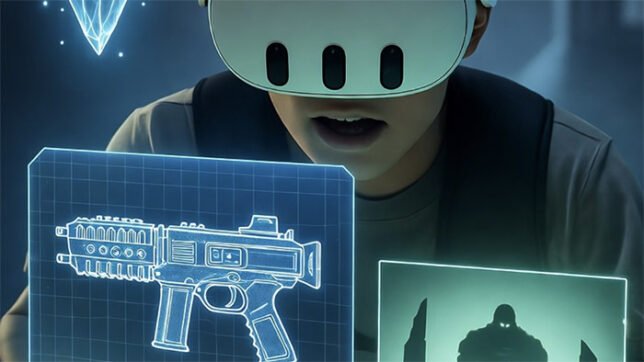In the ever-evolving landscape of virtual reality gaming, few titles capture the raw thrill of high-stakes survival like REQUISITION VR. Inspired by the tense, loot-driven chaos of Hunt: Showdown, this extraction shooter has carved out a niche on the Meta Quest, delivering pulse-pounding co-op action without the need for a beefy PC. But on October 12, 2025, developer HalfShell Studios announced a game-changing update set to launch on October 25—one that’s set to bring SteamVR players into full parity with their Quest counterparts. This isn’t just a patch; it’s a bridge between standalone VR and tethered PC powerhouses, promising reworked economies, brutal new bosses, and a arsenal of weapons that could redefine extraction shooters. If you’re a VR enthusiast itching for deeper strategy and cross-platform synergy, this update is your call to arms.

Whether you’re a seasoned looter dodging anomalies on the abandoned planet of Requiem or a SteamVR newcomer eyeing that seamless Quest-like flow, let’s dive into what makes this update a must-play milestone. And for more on the best co-op VR shooters hitting Meta Quest in 2025, check out our roundup of squad-based thrills.
What’s Dropping in the October 25 Update? A Breakdown of the Big Changes
At its core, the REQUISITION VR update is all about evolution—taking the game’s foundation of scavenging, crafting, and escaping under fire and amplifying it for both platforms. The reworked economy is the star here, shifting from a grind-heavy loot system to one that rewards smart risk-taking. Expect dynamic pricing for extracted goods based on server events, making every run feel like a high-wire act of supply and demand.
New bosses add layers of terror: hulking, anomaly-infused behemoths that adapt to your squad’s tactics, forcing on-the-fly adaptations. Picture a colossal guardian that phases through walls, only vulnerable during electrical surges—pure Hunt: Showdown vibes with a sci-fi twist. The weapon overhaul introduces modular attachments, letting you craft suppressors from scavenged parts or amp up rifles with alien tech for that satisfying VR recoil feedback.
Cross-platform parity means SteamVR users finally get the buttery-smooth performance Quest players have enjoyed, complete with optimized hand-tracking options and mixed-reality passthrough tweaks for hybrid play. No more clunky PCVR jank; this update ensures Requiem’s derelict halls load faster and hit harder, regardless of your rig.
For Quest owners, this is a reminder of why standalone VR keeps pulling ahead—check our guide on downloading VR games to Meta Quest if you’re gearing up for the drop.
Quest vs. SteamVR: How the Update Levels the Playing Field
One of the juiciest aspects of this update? It erases the divide between Quest’s wireless freedom and SteamVR’s graphical muscle. On Quest, REQUISITION has always shone with its lightweight 60Hz mode, letting you sprint through procedurally generated zones without a cable tethering you to your desk. The update polishes this further with enhanced crafting mechanics—now, you can blueprint weapons mid-run using intuitive gesture controls, turning scavenging into a tactile puzzle.
SteamVR players, long envious of that accessibility, now inherit the same economy tweaks and boss AI, but with room for mods via Steam Workshop integration. Imagine cranking up draw distances for those epic anomaly storms or layering in community skins for your squad’s gear. Performance-wise, expect 90Hz baselines on mid-tier GPUs, closing the gap on Quest 3’s native fluidity.
That said, Quest still edges out for pure immersion in extraction runs—its inside-out tracking shines during frantic exfils. If you’re bridging platforms, our Meta Quest 3 review highlights why it’s the ultimate hybrid headset for games like this.
Crafting Your Edge: Deep Dive into the New Mechanics
Crafting was always REQUISITION’s secret sauce, but the update turns it into a survivalist’s dream. Gone are the linear recipes; now, a dynamic workbench lets you fuse loot on the fly. Scavenge a rusted barrel? Combine it with anomaly shards for a breaching charge that stuns bosses. The economy ties in beautifully—rare mats fluctuate in value, so hoarding might tank your profits while bold trades yield premium upgrades.
This isn’t just busywork; it’s strategic depth that echoes Hunt‘s bloodline system but with VR’s physicality. Grip a half-assembled pistol in your hands, slot in components with precise finger curls, and test-fire against holographic targets. For SteamVR, haptic feedback gets a boost, simulating the clank of metal and sizzle of energy cells.
Drawing parallels to other tactical VR titles, it’s reminiscent of the exfil tension in Contractors Showdown: ExfilZone, where every extraction feels like a heist gone wrong. Pair this with the update’s new co-op voice chat filters for immersive squad banter, and you’re in for hours of emergent storytelling.
Pro tip: If you’re new to VR crafting, our VR setup guide covers optimizing your space for those marathon sessions.
Why This Update Keeps REQUISITION VR Competitive in the Hybrid Era
In 2025, VR’s hybrid era—blending standalone ease with PC power—is exploding, and REQUISITION’s update positions it as a frontrunner. While big-budget epics like Half-Life: Alyx dominate SteamVR charts, Quest’s ecosystem thrives on accessible gems like this. The parity push invites crossovers: Quest squads inviting Steam friends for asymmetric raids, where PC players handle heavy artillery while mobile teams flank.
This keeps the game fresh amid rising competition from indies and AAA ports. Think of it as VR’s answer to cross-play in battle royales—democratizing access without diluting quality. As VR trends for 2025 predict, updates like this will drive adoption, especially with Meta’s push for mixed-reality integrations.
For fans of intense co-op, it’s a beacon: REQUISITION isn’t just surviving the hybrid wave; it’s riding it to new heights.
Gear Up and Extract: Final Thoughts on the REQUISITION VR Revolution
The October 25 update isn’t hyperbole—it’s a pivotal moment for REQUISITION VR, transforming a solid Quest exclusive into a cross-platform powerhouse. Whether you’re fine-tuning loadouts on your Meta Quest 3S or modding mayhem on SteamVR, this drop promises the kind of replayable chaos that hooks you for weeks.
Dust off your headset, rally your crew, and prepare to requisition some glory. What’s your go-to extraction strat? Drop it in the comments below—we’re all ears (and anomaly detectors).




